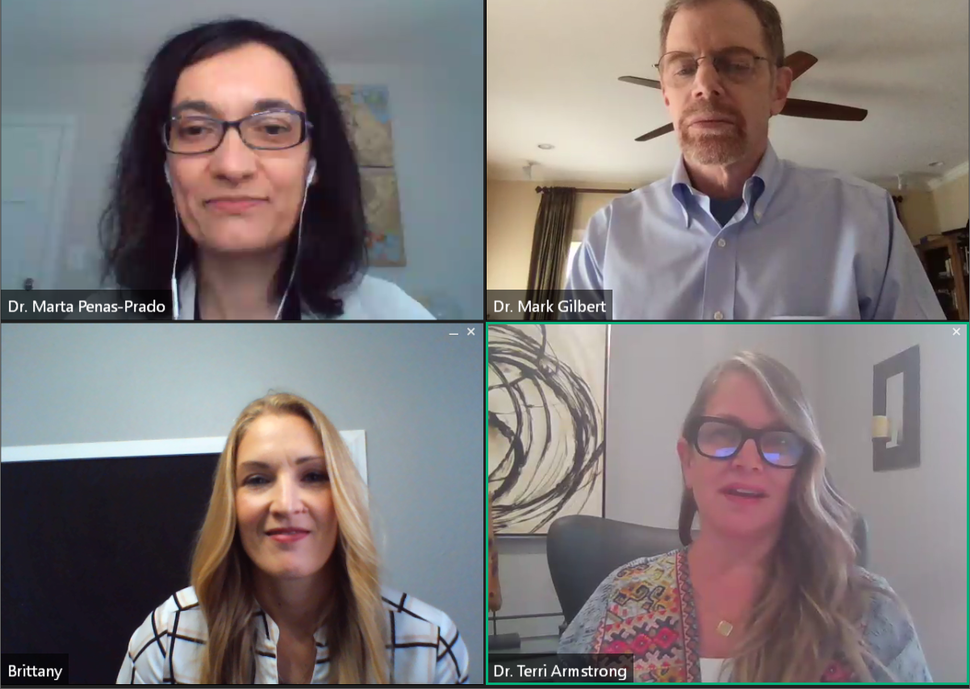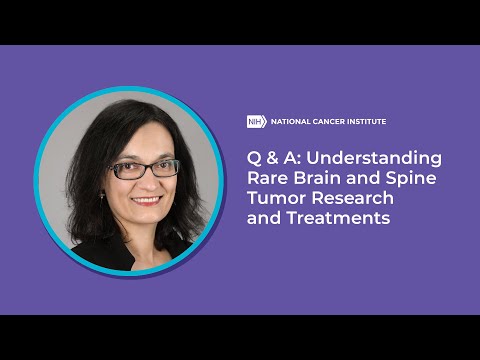Collaborating Globally to Impact Outcomes for Brain and Spine Cancers
, by Brittany Cordeiro, NCI-CONNECT Program Manager
World-renowned neuro-oncology researchers and health care providers gathered virtually to share their work, challenges, and possible solutions to improve patient outcomes across central nervous system cancers.
Neuro-oncology researchers and health care providers recognize that working together globally across all brain and spine cancers is the most effective path forward to improve treatments and outcomes. Researchers and health care providers took a giant step toward that goal at a virtual meeting ("Transdisciplinary Global Research in Rare CNS Tumors: A Framework to Impact Outcomes Across CNS Disease") on September 25, 2020, in partnership with the Society for Neuro-Oncology (SNO).
Nearly 300 neuro-oncology professionals tuned in, and 11 speakers from four countries presented on important topics in the field—including preclinical models, tumor classification and molecular analysis, clinical trial development and outcomes, and global collaborations. Within these topics, experts discussed advances, challenges, and possible solutions.
“I am incredibly hopeful for the future of brain and spine tumor research, because our symposium showed that it is possible to collaborate with specialists all over the world to learn things faster, enroll patients in clinical trials faster, and get answers to advance the field faster,” says Marta Penas-Prado, M.D., chair of the virtual symposium and an associate research physician in the NCI Center for Cancer Research's Neuro-Oncology Branch (NOB). Dr. Penas-Prado was joined by co-chairs Mark Gilbert, M.D., NOB chief, and Terri Armstrong, Ph.D., NOB deputy chief. Together, they led meaningful conversations.
Preclinical Models
The session started with speaker Eric Holland, M.D., Ph.D., senior vice president and director at the Human Biology Division and director of Seattle Translational Tumor Research at the Fred Hutchinson Cancer Research Center and University of Washington School of Medicine. Dr. Holland discussed pre-clinical models for rare central nervous system (CNS) tumors.
Dr. Holland showed the path of discovery, from driving molecular alterations to defining new tumor sub-types. These discoveries lead to the development of preclinical models and, ultimately, to the clinical trials available for patients. Importantly, preclinical models are used to test new treatments before they are tested in humans or used in clinical trials.
“It is incredibly difficult to completely reproduce human cancer. An approach is to take human tumor tissue to the laboratory and first create an in vitro or tissue culture model and then create an animal model for the purpose of testing,” explains Dr. Gilbert.
These preclinical models give us a lot of information about whether a treatment can impact a certain type or sub-type of cancer and what we need to do to bring it to a clinical trial.
Dr. Holland showed how a specific molecular abnormality in ependymoma called RELA-fusion was reproduced in an animal model. This very valuable preclinical model was the genesis of a clinical trial at NIH investigating if the drug marizomib is an effective treatment for people with recurrent ependymoma that have the RELA-fusion tumor marker.
Tumor Classification and Molecular Analysis
Kenneth Aldape, M.D., chief and senior investigator at the NCI Center for Cancer Research's Laboratory of Pathology, and Felix Sahm, M.D., Ph.D., managing senior physician and neuropathology section head of Molecular Neuropathology at Heidelberg University Hospital in Germany, showed state-of-the-art testing for accurate classification of rare CNS tumors and the essential role of molecular profiling tumors.
It is incredibly important to get an accurate diagnosis, because this is the building block to do absolutely everything else, including developing the treatment plan and providing a prognosis.
Up to 10 percent of people with brain and spine tumors receive an inaccurate diagnosis because doctors have not seen the tumor type before, or the hospital does not provide the type of pathology services needed.
In rare CNS tumors especially, Drs. Aldape and Sahm shared that neuropathologists are learning as they go by advancing molecular diagnostic techniques and analyzing more and more cases. To get an accurate diagnosis, people with rare tumor types should request additional testing at a center that can perform an integrated diagnosis, which is the combination of morphologic data with molecular data.
Collaboration in neuropathology has started with an initiative called cIMPACT-NOW. Neuropathologists are pulling together their experience and preparing for the update to the World Health Organization specification of tumors.
Clinical Trial Development and Outcomes
Drs. Gilbert and Armstrong provided a presentation on how new discoveries in the laboratory and basic science can be used to develop new treatments for different types of clinical trials—multi-center, basket, and disease-specific—that improve patient care. A clinical trial is a research study that tests a new medical treatment, drug, or device in people. Often, providers may only see a handful of patients with a particular rare CNS tumor type.
Having a clinical trial in which many patients are included helps us better evaluate the impact of treatment and make recommendations to future patients..
Importantly, incorporating patient-reported outcomes into clinical trials can evaluate how a patient feels and functions to help providers understand how a treatment affects a person’s quality of life. “We want to reduce symptoms like difficultly speaking, physical weakness, and cognitive problems that really impact a person’s ability to work and enjoy daily activities, ” says Dr. Armstrong.
Dr. Gilbert shared that the NCI-CONNECT program includes a network of centers across the United States that work together to identify patients with rare CNS tumors who are eligible for clinical trials and studies. For clinical trials at the Neuro-Oncology Branch that are part of the network, patients can participate at a center closer to their home. For international patients, there are additional clinical trial registries available online.
Global Collaborations
The symposium included vital and vibrant comments from Norman E. Sharpless, M.D., NCI director, Stephen M. Hahn, M.D., 24th Commissioner of Food and Drugs at the U.S. FDA, and Gelareh Zadeh, M.D., president of SNO, on their commitments and efforts to improve care for patients with rare CNS tumors. The voices of people with rare brain and spine tumors and their caregivers were also shared to help researchers and health care providers see what is important and exemplify their strength.
The symposium concluded with a panel discussion on the need for collaboration to move the field forward and possible solutions to make that happen. Panel members included neuro-oncologists, neurosurgeons, pathologists, and scientists from all over the world.
The panel focused on models to advance science and outcomes. Roel Verhaak, Ph.D., of The Jackson Laboratory developed a consortium called called GLASS to understand glioma tumor evolution and expose therapeutic vulnerabilities. It was initiated for community collaboration. Similarly, Elizabeth B. Claus, M.D., Ph.D., of Yale University and Brigham and Women's Hospital created a web-based study of low-grade gliomas with the goal to develop effective treatments.
Panelist continued to share effective models and discoveries while discussing significant challenges. Richard Gilbertson, Ph.D., of the CRUK Cambridge Institute in England studies pediatric brain tumors and is researching the role of aging. Erin Dunbar, M.D., of the Brain Tumor Center at Piedmont Healthcare shared her experiences as a community neuro-oncologist and the importance of developing clinical trials available to patients locally.
Martin van den Bent, M.D., Ph.D., of Erasmus MC Cancer Institute in the Netherlands is helping to lead an initiative in Europe focused on developing guidelines and providing people with brain tumors access to second opinions for diagnosis and treatment options. The initiative is known as "Domain 10 (Rare Brain and Spinal Cord Tumors)" within the European network for rare adult solid cancers called EURACAN. EURACAN is part of a European Commission initiative called European Reference Networks, which are virtual networks of health care providers across Europe tackling complex or rare diseases. Dr. Gilbert has relatable experience leading NCI-CONNECT and advising the Collaborative Ependymoma Research Network (CERN) Foundation—initiatives that focus on bringing people together to advance science for rare tumors.
The thought-provoking panel discussion demonstrated that international experts working together across CNS diseases can make a difference. “Global collaborations are essential to advance all cancer research, but this is particularly germane in the setting of rare cancers. We are hopeful that events like our symposium will be a starting point to work together to find better answers and outcomes for our patients,” says Dr. Gilbert.

